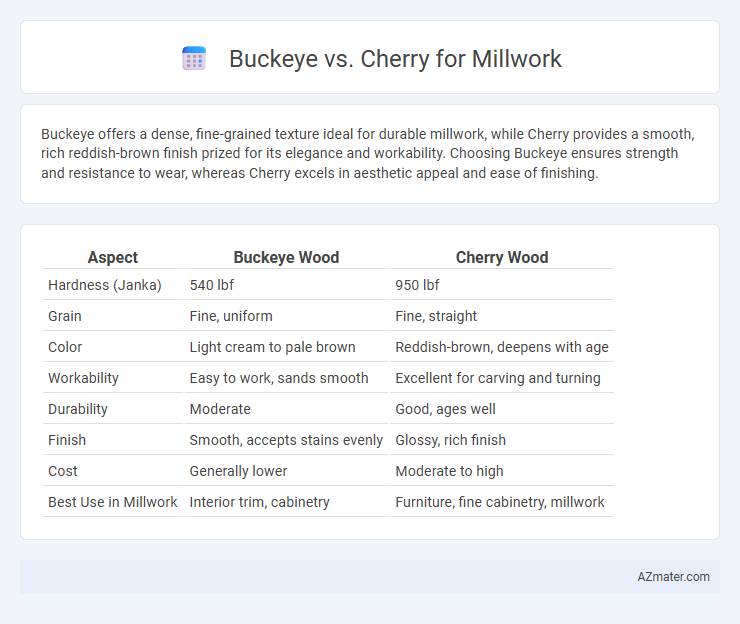Buckeye offers a dense, fine-grained texture ideal for durable millwork, while Cherry provides a smooth, rich reddish-brown finish prized for its elegance and workability. Choosing Buckeye ensures strength and resistance to wear, whereas Cherry excels in aesthetic appeal and ease of finishing.
Table of Comparison
| Aspect | Buckeye Wood | Cherry Wood |
|---|---|---|
| Hardness (Janka) | 540 lbf | 950 lbf |
| Grain | Fine, uniform | Fine, straight |
| Color | Light cream to pale brown | Reddish-brown, deepens with age |
| Workability | Easy to work, sands smooth | Excellent for carving and turning |
| Durability | Moderate | Good, ages well |
| Finish | Smooth, accepts stains evenly | Glossy, rich finish |
| Cost | Generally lower | Moderate to high |
| Best Use in Millwork | Interior trim, cabinetry | Furniture, fine cabinetry, millwork |
Introduction to Buckeye and Cherry Wood for Millwork
Buckeye and Cherry woods are highly valued in millwork for their unique characteristics and workability. Buckeye wood is known for its light color, fine texture, and uniform grain, making it ideal for detailed carvings and intricate millwork designs. Cherry wood features a rich, warm reddish-brown hue that darkens with age, offering durability and a smooth finish perfect for high-end millwork applications.
Botanical Origins and Growth Regions
Buckeye wood originates from the Aesculus genus, primarily found in North America's temperate forests, thriving in moist, well-drained soils across the eastern United States. Cherry wood comes from trees in the Prunus genus, predominantly the Black Cherry (Prunus serotina), native to eastern North America and known for its preference for rich, well-drained soils in mixed hardwood forests. The distinct botanical origins influence their grain patterns and color; Buckeye often exhibits a lighter, cream-colored tone with occasional dark streaks, while Cherry is prized for its rich reddish-brown hue that deepens with age and exposure.
Visual Characteristics: Color, Grain, and Figure
Buckeye wood features creamy white to light tan color with occasional reddish hues, exhibiting a smooth, interlocking grain that can create subtle swirling figure patterns, making it favored for decorative millwork. Cherry wood is prized for its rich, warm reddish-brown color that deepens with age and exposure to light, combined with a fine, straight grain and a natural, subtle luster enhancing the overall figure. The contrasting visual characteristics of Buckeye's lighter, variegated tones and Cherry's consistent, warm depth make them distinct choices for millwork projects requiring specific aesthetic appeals.
Mechanical Properties and Workability
Buckeye wood exhibits moderate mechanical properties, with a Janka hardness of around 540 lbf and good shock resistance, making it suitable for millwork requiring durability without excessive hardness. Cherry wood offers higher mechanical strength, with a Janka hardness near 950 lbf and excellent dimensional stability, providing superior wear resistance for detailed millwork applications. In terms of workability, Buckeye is prized for its softness and ease of carving, while Cherry, though harder, machines smoothly and finishes to a fine luster, balancing strength with fine craftsmanship demands.
Durability and Resistance to Wear
Buckeye wood offers moderate durability and resistance to wear, making it suitable for interior millwork that experiences light to medium use. Cherry wood boasts superior hardness and natural oils that enhance its resistance to wear, providing excellent durability for high-traffic areas in millwork applications. The dense grain structure of cherry also contributes to its ability to withstand dents and scratches better than buckeye.
Finishing Qualities and Aesthetic Appeal
Buckeye wood offers exceptional finishing qualities with a smooth, even grain that absorbs stains and finishes uniformly, resulting in a consistent and visually pleasing surface ideal for millwork projects. Cherry wood boasts a rich, natural reddish-brown hue that deepens with age and exposure to light, providing timeless aesthetic appeal and warmth in fine millwork applications. Both species are favored for their durability and ability to showcase detailed craftsmanship, but Cherry is often preferred for its distinctive color and elegant patina.
Cost Comparison and Market Availability
Buckeye wood typically offers a more affordable option for millwork compared to Cherry due to its faster growth rate and greater abundance in North American markets. Cherry wood commands higher prices reflecting its desirable grain pattern, durability, and strong demand among premium cabinetry and furniture manufacturers. While Buckeye may have limited availability regionally, Cherry is widely stocked by wholesalers and specialty lumber retailers, maintaining consistent market presence nationwide.
Environmental Impact and Sustainability
Buckeye wood is renowned for its rapid growth rate, making it a more sustainable choice for millwork due to lower environmental impact and faster renewable cycles compared to Cherry. Cherry wood, while prized for its rich color and durability, often involves longer harvesting periods and greater resource consumption, resulting in a higher ecological footprint. Selecting Buckeye for millwork projects supports reduced deforestation rates and promotes sustainable forestry practices through its efficient carbon sequestration and minimal chemical treatment requirements.
Best Millwork Applications for Buckeye vs Cherry
Buckeye wood, known for its lightweight and fine texture, excels in intricate millwork applications such as carved moldings, interior paneling, and decorative trim where ease of shaping and smooth finishes are essential. Cherry wood offers superior durability, rich color, and tight grain, making it ideal for high-end cabinetry, furniture, and architectural millwork that demands both aesthetic elegance and long-lasting performance. Selecting Buckeye for delicate detail work and Cherry for structural and visually prominent millwork ensures optimal results based on project requirements.
Choosing the Right Wood for Your Millwork Project
Buckeye offers a dense grain and rich brown tones, making it ideal for durable millwork with a rustic aesthetic. Cherry wood features a smooth texture and warm reddish hues that deepen with age, perfect for elegant and timeless millwork projects. Selecting Buckeye suits high-traffic areas requiring toughness, while Cherry excels in refined interiors needing a sophisticated finish.

Infographic: Buckeye vs Cherry for Millwork
 azmater.com
azmater.com